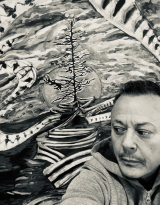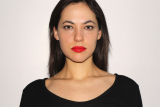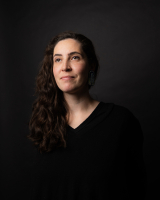
The Mellon ISCEI Artist in Residence program is an important means of bringing practicing artists to campus to continue their work, share their expertise, interact with students and faculty members, and enhance knowledge of and exposure to Indigenous art among the campus community and the public at large. The annual Artist in Residence will be co-organized with the Department of Art History & Communication Studies and will be involved in a variety of on-campus activities such as workshops and public exhibitions, and will be available as a resource to students, faculty, and staff.
Winter 2025 Artist-in-Residence
 MC Snow is a transdisciplinary artist living in Kahnawake. After obtaining his BFA from the University of Ottawa in 1987, Snow returned to the Kanien”keha:ka community situated on the St Lawrence river,across from the city of Montreal (Tiotiake). He became known as an artist through his early work with the Turtle Island Theatre Company ,the after school art program at the Kahnawake Youth Center, and the Mohawk curriculum Center.
MC Snow is a transdisciplinary artist living in Kahnawake. After obtaining his BFA from the University of Ottawa in 1987, Snow returned to the Kanien”keha:ka community situated on the St Lawrence river,across from the city of Montreal (Tiotiake). He became known as an artist through his early work with the Turtle Island Theatre Company ,the after school art program at the Kahnawake Youth Center, and the Mohawk curriculum Center.
Snow’s focus as an artist is grounded in traditional indigenous arts and techniques.His concerns lean into the concept of transmission of cultural traditions, ways ,and belief systems. Favored mediums include the traditional crafting techniques of regalia, the contrast of pre-colonial and modern art materials, the fusion of blended techniques and resiliency of hybrid innovations.
Snow has been a participant in the Biennale Arts Contemporains Autochtone for the past 6 years, has showed at many galleries and group shows across the province and United States,and the Biennale Metiers d’Arts de Paris , Révélations ,with the honoured representatives of the Province of Quebec in Paris,2023.
In 2023,24,Snow was the artist in residence at the McCord Stewart Museum in Montreal with his exhibit Presence of the Past. This expo paralleled 2 new sculptures with 40 objects selected from the rarely seen collections of indigenous artifacts and objects being housed at the museum. The value of the input of the original communities from which these objects were collected is highlighted and brought to front of focus. Présence du Passé also sheds some light into the ongoing digs in Tiotiake that continue to unearth the voices of our ancestors.
From 2017 to 2024,MC worked with the City of Montreal to co-create Our Ways:Peel Trail. In a close partnership with the creative teams of Tiotiake and artist Kyra Revenko,the 11 stations of bronze spherical chairs dialogue at various intersections along Peel street. These are markers to commemorate the memory of our original settlements. It also seats us on the Haudenosaunee Thanksgiving Adress .The seats evoke a safe space for dialogue that contrasts the distinct histories of our new neighbours, the often conflicting values, the shared loyalties to our separate identities, and the road ahead of us.
Previous Residencies
Caroline Monnet
 Monnet's work in film, painting and sculpture deals with complex ideas around Indigenous identity and bicultural living through the examination of cultural histories. She is interested in themes of identity, representation, and modernity. Monnet has made a signature for working with industrial materials, combining the vocabulary of popular and traditional visual culture with the tropes of modernist abstraction to create unique hybrid forms.
Monnet's work in film, painting and sculpture deals with complex ideas around Indigenous identity and bicultural living through the examination of cultural histories. She is interested in themes of identity, representation, and modernity. Monnet has made a signature for working with industrial materials, combining the vocabulary of popular and traditional visual culture with the tropes of modernist abstraction to create unique hybrid forms.
Her work has been programmed internationally at the Palais de Tokyo (Paris), Haus der Kulturen der Welt (Berlin), TIFF (CAN), Sundance (US), Aesthetica (UK), Palm Springs (USA), Cannes Film Festival, Museum of Contemporary Art (Montréal), Arsenal Contemporary NY, Axenéo7 (Gatineau), Walter Phillips Gallery (Banff), Division Gallery (Montréal) and the National Art Gallery (Ottawa).
In 2016, she was selected for the prestigious Cinéfondation residency in Paris. Caroline Monnet's art has also been included in numerous collections including Quebec Museum of Fine Arts, National Art Gallery, RBC Royal Bank, and Museum of Contemporary Art Montréal. Current exhibitions include the Whitney Biennial and the Toronto Biennale of Art 2019. She is based in Montréal and represented by Division Gallery.
You can view more of Caroline's work on her website.
Proximal I, II, III, IV, V, 2018:
 The sculptural complement to Transatlantic is Proximal I-V, a set of five concrete spheres set atop glossy black plinths. In their scattered arrangement, the plinths reflect the landmasses that morph in and out of view toward the beginning and end of the film, and the spheres atop them refer to the standing stones of the Neolithic people of north-western France and the earthen mounds of the Great Lakes.
The sculptural complement to Transatlantic is Proximal I-V, a set of five concrete spheres set atop glossy black plinths. In their scattered arrangement, the plinths reflect the landmasses that morph in and out of view toward the beginning and end of the film, and the spheres atop them refer to the standing stones of the Neolithic people of north-western France and the earthen mounds of the Great Lakes.
The spheres are something between way stone and grave marker. Through the marriage of industrial processes and the water of an unspecified location, they become both guideposts and monuments to bodies unmoored in the interstices of the global.
360 Degrees
This short film introduces us to Sébastien Aubin, a French-speaking member of Manitoba's Opaskwayak Cree Nation. He works as a graphic artist for a living, but he's embarked on a personal spiritual and identity quest on the side. Attempting to transcend the material world, he's apprenticing in traditional Indigenous medicine with healer Mark Thompson. The relationship between the two figures marks the contrast between generations; between modernity and tradition. It makes the 360-degree turn from the values of the past to those of today strikingly apparent.
The Flow Between Hard Places (2019)
 The undulating edges of this monumental sculpture represent the sound waves created in uttering the word pasapkedjinawong (“the river that passes between the rocks”) in Anishinaabemowin, as spoken by Anishnaabe Elder Rose Wawatie-Beaudoin.
The undulating edges of this monumental sculpture represent the sound waves created in uttering the word pasapkedjinawong (“the river that passes between the rocks”) in Anishinaabemowin, as spoken by Anishnaabe Elder Rose Wawatie-Beaudoin.
Dayna Danger
 Dayna Danger (they/them) is a Two-Spirit, Indigiqueer, Métis-Saulteaux-Polish visual artist. Danger was raised in Miiskwaagamiwiziibiing, Treaty 1 territory, or so-called Winnipeg. They are currently based in Tiohtiá:ke/Mōniyāng, or so-called Montreal. Through utilizing the processes of photography, sculpture, performance and video, Danger creates works and environments that question the line between empowerment and objectification by claiming the space.
Dayna Danger (they/them) is a Two-Spirit, Indigiqueer, Métis-Saulteaux-Polish visual artist. Danger was raised in Miiskwaagamiwiziibiing, Treaty 1 territory, or so-called Winnipeg. They are currently based in Tiohtiá:ke/Mōniyāng, or so-called Montreal. Through utilizing the processes of photography, sculpture, performance and video, Danger creates works and environments that question the line between empowerment and objectification by claiming the space.
Ongoing works exploring bdsm and beaded leather fetish masks negotiate the complicated dynamics of sexuality, gender, and power in a consensual and feminist manner. Their focus remains on Indigenous and Métis visual and erotic sovereignty. Danger has exhibited their work most recently at the National Gallery of Canada with Àbadakone | Continuous Fire | Feu continuel and was long-listed for the 2021 Sobey Art award. Danger was featured on the cover of Canadian Art’s June 2018 Kinship issue. Danger has participated in residencies at the Banff Centre for the Arts and at Plug In Institute of Contemporary Art. In 2021, they began a doctorate at Concordia University that focuses on hide-tanning stories and bush skills, culture camps, passed on from their Saulteaux great-grandmother, Madeline McLeod (Campbell).
Big'Uns
 Big‘Uns explores the reclaiming of the bodies and sexualities of trans, non-binary, femme, and female-identified individuals.
Big‘Uns explores the reclaiming of the bodies and sexualities of trans, non-binary, femme, and female-identified individuals.
“In today’s culture, trans, non-binary, and women-identified individuals often lack power over their own sexuality. This occurs through misrepresentation, objectification, and violence against us in various media, even hunting magazines. Sport hunting uses language that is violent and oppressive to us as well as to animals. In their essay “Animals, Women, and Weapons: Blurred Sexual Boundaries in the Discourse of Sport Hunting” from 2004, Kalof, Fitzgerald and Baralt conclude that “Animals’ physical attributes are described using stereotypical feminine characteristics of appearance.” An example is the use of “Big’uns” to describe an animal’s antlers. This type of language usage plays a key role in disempowering our sexuality.
Big’Uns is an ongoing photographic portrait series that explores reclaiming sexuality and our bodies. By repossessing antlers in this way, we aim to demonstrate a reclaiming of power for trans, non-binary, and women-identified individuals and how we choose to be seen.”
In the Studio
Tiffany Shaw
 Tiffany Shaw is a Métis architect, artist and curator based in Alberta. She holds a BFA from Nova Scotia College of Art and Design (NSCAD) University, a Masters in Architecture from the Southern California Institute of Architecture (SCI-Arc) and is currently working at Reimagine Architects. Shaw has exhibited widely including the Architecture Venice Biennale, Winnipeg Art Gallery, Pier 21, Agnes Etherington Art Centre and the Chicago Architecture Biennial. She has been the recipient of multiple public art commissions such as Edmonton's Indigenous Art Park and Winnipeg’s Markham Bus Station. Among her public art projects Tiffany has produced several notable transitory art works and is a core member of Ociciwan Contemporary Art Collective.
Tiffany Shaw is a Métis architect, artist and curator based in Alberta. She holds a BFA from Nova Scotia College of Art and Design (NSCAD) University, a Masters in Architecture from the Southern California Institute of Architecture (SCI-Arc) and is currently working at Reimagine Architects. Shaw has exhibited widely including the Architecture Venice Biennale, Winnipeg Art Gallery, Pier 21, Agnes Etherington Art Centre and the Chicago Architecture Biennial. She has been the recipient of multiple public art commissions such as Edmonton's Indigenous Art Park and Winnipeg’s Markham Bus Station. Among her public art projects Tiffany has produced several notable transitory art works and is a core member of Ociciwan Contemporary Art Collective.
Oscillating between digital and analogue methodologies Shaw’s work gathers notions of craft, memory and atmosphere. Her practice is often guided by communal interventions as a way to engage a lifted understanding of place. While born in Calgary and raised in Edmonton, Shaw’s Métis lineage derives from Fort McMurray via Fort McKay and the Red River.
To learn more about Tiffany and to view a selection of her work, visit her website.
 Soleil Launière
Soleil Launière
Originally from the Ilnu community of Mashteuiatsh, Soleil Launière lives and works in Tiöhtià:ke - Mooniyang (Montreal). A transdisciplinary artist combining song, movement, theater, installation and performance art, she sporadically uses experimental multimedia to make spiritual in-betweens felt. Since 2008, Soleil has created several performances for Aboriginal and non-Aboriginal artistic gatherings and events, both inside and outside traditional dissemination networks, and across continents. Umanishish, her first major production, premiered at Usine C in 2019. That same year, she appeared in Là où le sang se mêle on the stages of the National Arts Centre and Le Diamant. The following year, she co-directed Courir l'Amérique at Théâtre Quat'Sous and produced Sheuetamu at M.A.I in Montreal. In 2021, she created Meshtitau at the Festival Trans-Amérique. Akuteu, her first theatrical text and most recent creation, was brought to the stage in 2022 at Théâtre d'Aujourd'hui.
Since 2020, she has been Associate Artist and Professor at the National Theatre School of Canada and Director of Production AUEN, the company she founded. She is currently artistic consultant to Mirari and Robert Lepage for the Oaxaca World Expo 2025. A new mother, she launched her first music album, Taueu, and saw her text Akuteu published by Remue-ménage.
Soleil Launière draws inspiration from her own experience, from myths and the spirit of animals. She creates passages between the visible and invisible worlds, as well as between diverse realities such as her two-fold spirituality and her dual Ilnu and Québécois culture. Sensitive and powerful, her presence, voice and works leave no one indifferent.
You can read more about this initiative by referring to Call to Action #25 in the Provost’s Task Force on Indigenous Studies and Indigenous Education report linked here: